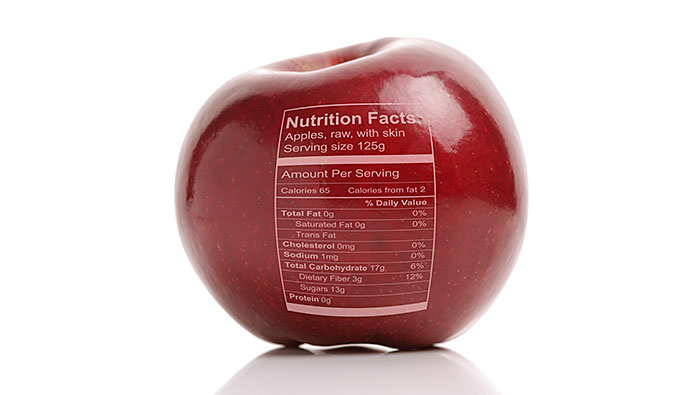
Well, hello there, First Lady Michelle Obama. Moving away from her well-intentioned but not-so-impactful gardening lessons for kids, Obama has really come into her own and is fast becoming a nutrition policy change-maker. The new significant changes proposed for nutrition labels by the Food and Drug Administration and the Obama Administration Thursday may be significant enough to empower the consumer to take back Big Food’s wild, wild American grocery aisle. Alas, the American consumer just scored, big time, in the match against obesity.
The nutrition label changes are being called “major” and “sweeping,” and for good reason.
“Absolutely these changes can make a dent in the obesity epidemic,” Dr. Lisa Young, author of “Portion Teller” and adjunct NYU nutrition professor, told CBS. “Obesity is a big problem. We need to cut to the chase: calories, added sugars and serving size.”
Believe it or not, nutrition labels have not changed in the last 20 years. It was only in the late ’60s that most food labels even listed nutritional info — and doing so was voluntary, not mandated then. It was not until 1990 that the FDA required most processed and prepared foods to have nutrition labels (following the processed-foods surge of the ’50s).
More:
Read more: Poison ivy employee extorts boss with $850 million, fake Swedish “model” fled America
While the idea of making additional changes to already confusing, tricky labels has been criticized in the past, for fear that additional changes would just further befuddle an already confounded American public even more, I must say that these proposed changes are encouraging and positive — a success for American food consumers. (FLOTUS has got your back!) If put into place, which would take about two years, it could really shake up the food industry and has the potential to put a large dent in the obesity epidemic.
“The changes greatly improve clarity. Consumers do not want to do math when they eat. The new label is bolder in highlighting the ‘need to know’ content,” says Toby Smithson, RDN/LDN, a spokesperson for the Academy of Nutrition and Dietetics, which released a statement commending the FDA’s proposal. “In our fast-paced society, it is better to highlight the ‘need to know’ facts rather than extra information such as calories from fat.”
Some of the most buzzed-about, proposed nutrition label updates include:
* When listing sugars, the amount of “added sugars” would be listed.
Why is this good? If you’ve been reading my articles, you know that certain nutritious foods, such as fruits, contain natural sugars along with their superfood antioxidants and vitamins. “There are healthy food choices such as fruit, yogurt and low-fat milk that contain sugar, but the sugar is naturally occurring. There is a big difference between food choices with natural sugar and foods loaded with added sugars,” says Smithson. “Foods high in added sugars that are not naturally occurring tend to be high in calories and low in nutrients. Separating out added sugars on nutrition labels will help consumers make wiser food choices. Currently, the only way a consumer can identify added sugars is by reading the ingredient lists, which don’t give numbers and list a ton of sugar aliases.”
* The “Calories From Fat” line will be removed, shifting focus instead to total calories found in each serving (fat will still be broken down on label as saturated, monounsaturated, etc.).
Why is this good? Nutritionists now understand that not all fat is bad fat, and knowing what type of fat you are consuming is more useful than knowing “calories from fat.”
More:
* The listed serving sizes will be more realistic.
Why is this good? “The serving sizes will now be realistic,” says Dr. Young. The fact is, she says, that we are eating more than we used to. But, she clarifies, “FDA is not telling us to eat more by making serving sizes larger. They are just telling us what’s really in this product. Nobody really just eats a half-cup of ice cream, which had previously been the listed serving size.” As Politico aptly put it, “Americans are in for a reality check about how many calories and how much sugar they are consuming.”
*There will be bigger, bolder calorie counts.
Along with sugar, sodium, ingredients and nutrients included in the food you are eating, the listed calories are more of a quick-glance, need-to-know information. They should stand out.
*As proposed additions, the FDA will update daily values for some nutrients including vitamin D, dietary fiber, and sodium.
Why is this good? We now know that many Americans are low in vitamin D and fiber and that many Americans consume way too much sodium, contributing to heart disease, which is still the number one killer in America.
The idea here is to actually make it easier, not harder for all consumers to understand what they are buying, what they are eating, and how many calories they consume when they’re eating — without having to receive a master’s degree in label reading.
The Center For Science in the Public Interest applauded the FDA’s action, but added that the FDA’s recommended sodium intake is still excessive (CSPI recommends limiting daily sodium to 1,500 mg daily), reported the New York Times. The group would also love to see labels include the “daily value” for sugar, so that, for example, a 16.9-ounce soda, containing 58 g of added sugars, would show its near absurd truth of containing 230 percent of the DV.
More:
The Curious Case of Fabrice Tourre, Scapegoat of Regulatory Abusers…
Read more: Want to lose your entire life savings? Ask Nasdaq Stock Market official Michael Emen
As Dr. Marion Nestle points out on her Food Politics blog, the proposals are scheduled for publication in the Federal Register on March 3. The FDA will collect comments from the American public for 90 days. There will be instructions on the website FDA.gov.
Two sets of proposed rules will be open for comment. The first is called “Food Labeling: Revision of the Nutrition and Supplement Facts Label” (it’s 367 pages). The second is called “Serving Sizes of Food That Can Reasonably Be Consumed at One-Eating Occasion; Dual-Column Labeling; Updating, Modifying, and Establishing Certain Reference Amounts Customarily Consumed; Serving Size for Breath Mints; and Technical Amendments” (it’s 145 pages).
The FDA will then issue a final rule (which officials want to complete this year) and food manufacturing companies will have two years to implement changes. It’s estimated by the FDA that making such changes could cost the food industry $2 billion. The overhaul has been in the works at the FDA for the last 10 years, but it’s said that it was Michelle Obama’s staff whose muscle got the proposal out the door at last.
More:
Set a calendar alert (or follow me on Twitter, where I’ll be reminding you). You are an American. You have a voice. You should use it. If you want to be part of the obesity solution, go to the FDA’s website and post your comment. Your time has come, Dear Reader-Consumer. Let your voice be heard.





